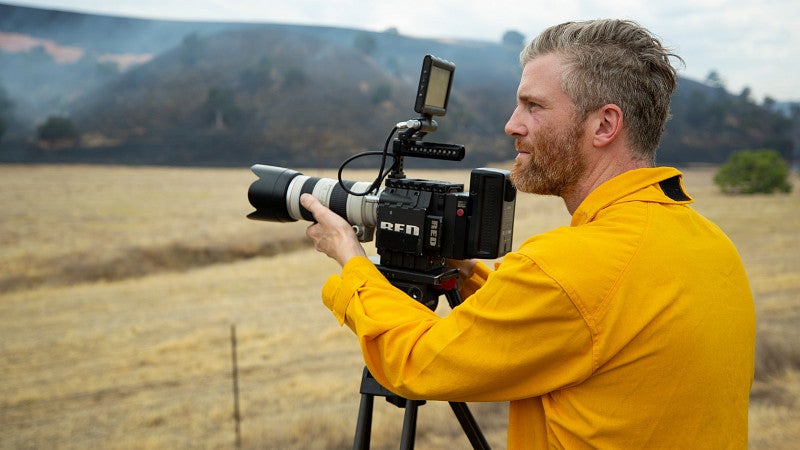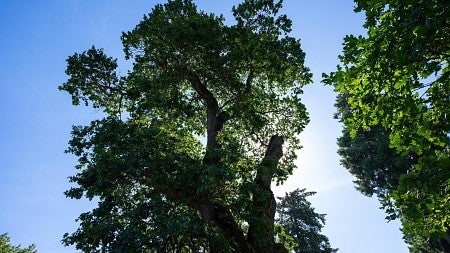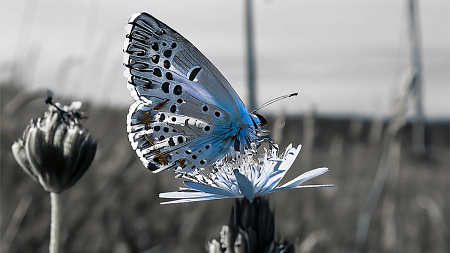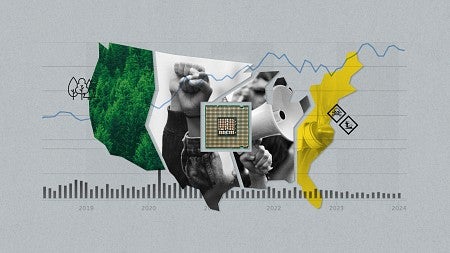
Documenting an Elemental Approach to Wildfire
UO alumnus Trip Jennings created the documentary “Elemental,” examining ways to live with fire
By Tim Christie • Photo by Sara Quinn • October 5, 2022
5 min readTrip Jennings first started learning about the complexities of wildfire when he was an undergraduate at the University of Oregon twenty years ago.
The Virginia native had been making films and videos since high school, mostly about whitewater kayaking, his passion. Two friends in the School of Journalism and Communication, Kyle Dickman and Becky Kennedy, asked for his help with a project.
The project involved the 2002 Biscuit Fire, a conflagration in southern Oregon and northern California that burned nearly five hundred thousand acres. The fire, and efforts to conduct salvage logging in its aftermath, were in the news.
“They said, ‘For this project we want to make a film instead of writing an article, would you like to collaborate?’” says Jennings, BA ’06 (Spanish). “I was like, ‘Totally.’”
The project, for which Jennings received an independent study credit, was his first brush with forest and wildfire politics in the West, but not the last.
Two decades later, Jennings has a new film about wildfire called Elemental, which premiered in Portland in July and is now on the festival circuit, including at the Mill Valley Film Festival, a long-running event in the Bay Area that highlights independent and international film. The film had a weeklong run in September at the Art House theater in Eugene.
Jennings and his collaborators spent nearly five years on the film, visiting burned landscapes and communities devasted by wildfire.
“I have visited with scientists, investigators, and firefighters,” he says, “and they have told me again and again that we can have healthy forests and safe communities, and that we can prepare for and adapt to fire.”
Jennings, a forty-year-old Portland resident, says he hopes the film helps change the national conversation around wildfire.
He directed and cowrote the film and served as director of photography. Among his collaborators was Sara Quinn, BA ’11 (Clark Honors College, anthropology), who served as producer and editor. Jennings and Quinn have known each other since their undergraduate days, when both were residents of the Lorax, the student housing cooperative on Alder Street. They have been working together since 2014.
After college, Jennings continued making films in collaboration with National Geographic, telling stories of ecosystems around the globe combined with his love of whitewater kayaking.
He came back to fire in 2017 when the Eagle Creek Fire tore through the Columbia River Gorge east of Portland, burning fifty thousand acres over three months.
“That was a real turning point in Oregon, especially for people in Portland,” Jennings says. As ash rained down on the city, talk of climate change was no longer an abstract concept, he says.
“That fire was clearly within the spectrum of what was very normal for the gorge, but we hadn’t experienced fire like that in almost one hundred years,” he says. “It was a bit of a wake-up call.”
As Jennings began working on his new film, he thought the story would be that so many of these landscapes are due for fire, and more prescribed burns should be done to lessen their ferocity.
What changed his thinking about wildfire was a conversation he had with a scientist about the appropriate role for prescribed fire. The scientist told him that prescribed burns have their role, but that anything done to treat the forest or fuels that is farther than one hundred feet from a home has little to no effect on whether the house will burn in a wildfire.
Jennings’s epiphany was that the issue is not the forests or grasslands or chapparal that burn, but rather “the problem is homes are burning and people are dying in these fires, firefighters and residents,” he says. “So the solution has to come from the home out, and that’s what the science says.”
Firefighters are extremely effective at controlling wildfires, but the 2 percent of fires that can’t be controlled cause rampant damage and loss of life. The Camp Fire in 2018 was the deadliest and most destructive fire in California history, killing eighty-six people and destroying eighteen thousand structures. In 2020, Labor Day fires, including the Holiday Farm Fire along the McKenzie River corridor, killed eleven people and destroyed thousands of homes in Oregon, effectively destroying the communities of Blue River, Phoenix, Gates, and Detroit.
“What we need to do is think about the values that are most important to us,” he says, “and that’s homes, communities, and people.”
Some relatively simple fixes to homes in fire zones can help structures survive wildfires—such as sealing attic vents with mesh screens to keep embers out and installing hardscapes next to houses, instead of gardens. More expensive fixes include replacing single-pane windows with tempered triple-pane glass that can withstand the furious winds and windblown debris that can occur in a wildfire.
It’s not a wall of fire that moves through a community and burns homes, it’s embers that blow into a house and catch it on fire.
Says Jennings: “You need to protect your house from that one ember.”
Elemental is “not a doom and gloom documentary,” according to Jennings, despite harrowing scenes of people fleeing flames in Paradise, California, in 2018.
“This is a story that has a solution to a problem. We have the technology and the capacity to protect our homes and communities from wildfire,” he says. “We just have to have the will to do it.”
Tim Christie is a staff writer for University Communications.




